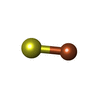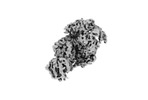[English] 日本語
 Yorodumi
Yorodumi- EMDB-19109: Structure of XPD stalled at a Y-fork DNA containing a interstrand... -
+ Open data
Open data
- Basic information
Basic information
| Entry |  | |||||||||
|---|---|---|---|---|---|---|---|---|---|---|
| Title | Structure of XPD stalled at a Y-fork DNA containing a interstrand crosslink | |||||||||
 Map data Map data | Full map of Class1 B-factor sharpened | |||||||||
 Sample Sample |
| |||||||||
 Keywords Keywords | damaged DNA / helicase / XPD / NER / DNA repair / interstrand crosslink / DNA BINDING PROTEIN | |||||||||
| Function / homology |  Function and homology information Function and homology informationpositive regulation of mitotic recombination / nucleotide-excision repair factor 3 complex / hydrolase activity, acting on acid anhydrides, in phosphorus-containing anhydrides / DNA 5'-3' helicase / transcription factor TFIIH core complex / transcription factor TFIIH holo complex / DNA helicase activity / nucleotide-excision repair / 4 iron, 4 sulfur cluster binding / damaged DNA binding ...positive regulation of mitotic recombination / nucleotide-excision repair factor 3 complex / hydrolase activity, acting on acid anhydrides, in phosphorus-containing anhydrides / DNA 5'-3' helicase / transcription factor TFIIH core complex / transcription factor TFIIH holo complex / DNA helicase activity / nucleotide-excision repair / 4 iron, 4 sulfur cluster binding / damaged DNA binding / transcription by RNA polymerase II / DNA-templated transcription / regulation of transcription by RNA polymerase II / zinc ion binding / ATP binding / metal ion binding Similarity search - Function | |||||||||
| Biological species |  Thermochaetoides thermophila (fungus) / Thermochaetoides thermophila (fungus) /  Homo sapiens (human) Homo sapiens (human) | |||||||||
| Method | single particle reconstruction / cryo EM / Resolution: 3.1 Å | |||||||||
 Authors Authors | Kuper J / Hove T / Kisker C | |||||||||
| Funding support |  Germany, 1 items Germany, 1 items
| |||||||||
 Citation Citation |  Journal: Nat Struct Mol Biol / Year: 2024 Journal: Nat Struct Mol Biol / Year: 2024Title: XPD stalled on cross-linked DNA provides insight into damage verification. Authors: Jochen Kuper / Tamsanqa Hove / Sarah Maidl / Hermann Neitz / Florian Sauer / Maximilian Kempf / Till Schroeder / Elke Greiter / Claudia Höbartner / Caroline Kisker /  Abstract: The superfamily 2 helicase XPD is a central component of the general transcription factor II H (TFIIH), which is essential for transcription and nucleotide excision DNA repair (NER). Within these two ...The superfamily 2 helicase XPD is a central component of the general transcription factor II H (TFIIH), which is essential for transcription and nucleotide excision DNA repair (NER). Within these two processes, the helicase function of XPD is vital for NER but not for transcription initiation, where XPD acts only as a scaffold for other factors. Using cryo-EM, we deciphered one of the most enigmatic steps in XPD helicase action: the active separation of double-stranded DNA (dsDNA) and its stalling upon approaching a DNA interstrand cross-link, a highly toxic form of DNA damage. The structure shows how dsDNA is separated and reveals a highly unusual involvement of the Arch domain in active dsDNA separation. Combined with mutagenesis and biochemical analyses, we identified distinct functional regions important for helicase activity. Surprisingly, those areas also affect core TFIIH translocase activity, revealing a yet unencountered function of XPD within the TFIIH scaffold. In summary, our data provide a universal basis for NER bubble formation, XPD damage verification and XPG incision. | |||||||||
| History |
|
- Structure visualization
Structure visualization
| Supplemental images |
|---|
- Downloads & links
Downloads & links
-EMDB archive
| Map data |  emd_19109.map.gz emd_19109.map.gz | 111 MB |  EMDB map data format EMDB map data format | |
|---|---|---|---|---|
| Header (meta data) |  emd-19109-v30.xml emd-19109-v30.xml emd-19109.xml emd-19109.xml | 20.5 KB 20.5 KB | Display Display |  EMDB header EMDB header |
| Images |  emd_19109.png emd_19109.png | 30.7 KB | ||
| Filedesc metadata |  emd-19109.cif.gz emd-19109.cif.gz | 7.2 KB | ||
| Others |  emd_19109_additional_1.map.gz emd_19109_additional_1.map.gz emd_19109_half_map_1.map.gz emd_19109_half_map_1.map.gz emd_19109_half_map_2.map.gz emd_19109_half_map_2.map.gz | 194.5 MB 200.2 MB 200.2 MB | ||
| Archive directory |  http://ftp.pdbj.org/pub/emdb/structures/EMD-19109 http://ftp.pdbj.org/pub/emdb/structures/EMD-19109 ftp://ftp.pdbj.org/pub/emdb/structures/EMD-19109 ftp://ftp.pdbj.org/pub/emdb/structures/EMD-19109 | HTTPS FTP |
-Related structure data
| Related structure data |  8revMC M: atomic model generated by this map C: citing same article ( |
|---|---|
| Similar structure data | Similarity search - Function & homology  F&H Search F&H Search |
- Links
Links
| EMDB pages |  EMDB (EBI/PDBe) / EMDB (EBI/PDBe) /  EMDataResource EMDataResource |
|---|---|
| Related items in Molecule of the Month |
- Map
Map
| File |  Download / File: emd_19109.map.gz / Format: CCP4 / Size: 216 MB / Type: IMAGE STORED AS FLOATING POINT NUMBER (4 BYTES) Download / File: emd_19109.map.gz / Format: CCP4 / Size: 216 MB / Type: IMAGE STORED AS FLOATING POINT NUMBER (4 BYTES) | ||||||||||||||||||||||||||||||||||||
|---|---|---|---|---|---|---|---|---|---|---|---|---|---|---|---|---|---|---|---|---|---|---|---|---|---|---|---|---|---|---|---|---|---|---|---|---|---|
| Annotation | Full map of Class1 B-factor sharpened | ||||||||||||||||||||||||||||||||||||
| Projections & slices | Image control
Images are generated by Spider. | ||||||||||||||||||||||||||||||||||||
| Voxel size | X=Y=Z: 0.84 Å | ||||||||||||||||||||||||||||||||||||
| Density |
| ||||||||||||||||||||||||||||||||||||
| Symmetry | Space group: 1 | ||||||||||||||||||||||||||||||||||||
| Details | EMDB XML:
|
-Supplemental data
-Additional map: Full Map of Class2 DeepEMhancer sharpened
| File | emd_19109_additional_1.map | ||||||||||||
|---|---|---|---|---|---|---|---|---|---|---|---|---|---|
| Annotation | Full Map of Class2 DeepEMhancer sharpened | ||||||||||||
| Projections & Slices |
| ||||||||||||
| Density Histograms |
-Half map: Class1 Half Map
| File | emd_19109_half_map_1.map | ||||||||||||
|---|---|---|---|---|---|---|---|---|---|---|---|---|---|
| Annotation | Class1 Half Map | ||||||||||||
| Projections & Slices |
| ||||||||||||
| Density Histograms |
-Half map: Class 1 Half Map
| File | emd_19109_half_map_2.map | ||||||||||||
|---|---|---|---|---|---|---|---|---|---|---|---|---|---|
| Annotation | Class 1 Half Map | ||||||||||||
| Projections & Slices |
| ||||||||||||
| Density Histograms |
- Sample components
Sample components
-Entire : XPD-p44 complex bound to DNA
| Entire | Name: XPD-p44 complex bound to DNA |
|---|---|
| Components |
|
-Supramolecule #1: XPD-p44 complex bound to DNA
| Supramolecule | Name: XPD-p44 complex bound to DNA / type: complex / ID: 1 / Parent: 0 / Macromolecule list: #1-#2 |
|---|---|
| Source (natural) | Organism:  Thermochaetoides thermophila (fungus) Thermochaetoides thermophila (fungus) |
-Macromolecule #1: ATP-dependent DNA helicase CHL1
| Macromolecule | Name: ATP-dependent DNA helicase CHL1 / type: protein_or_peptide / ID: 1 / Number of copies: 1 / Enantiomer: LEVO / EC number: DNA helicase |
|---|---|
| Source (natural) | Organism:  Thermochaetoides thermophila (fungus) Thermochaetoides thermophila (fungus) |
| Molecular weight | Theoretical: 91.847172 KDa |
| Recombinant expression | Organism:  |
| Sequence | String: MEFMIDDLPV LFPYPRIYPE QYAYMCDLKK TLDAGGNCVL EMPSGTGKTI TLLSLIVAYQ QHYAEHRKLI YCSRTMSEIE KALVELKAL MKFRAERLGY VEEFRGLGLT SRKNLCLHPS VKREKSGTIV DARCRSLTAG FVKEKKQRGE DVDVCIYHDN L DLLEPHNL ...String: MEFMIDDLPV LFPYPRIYPE QYAYMCDLKK TLDAGGNCVL EMPSGTGKTI TLLSLIVAYQ QHYAEHRKLI YCSRTMSEIE KALVELKAL MKFRAERLGY VEEFRGLGLT SRKNLCLHPS VKREKSGTIV DARCRSLTAG FVKEKKQRGE DVDVCIYHDN L DLLEPHNL IPNGIWTLDN LLKYGEEHKQ CPYFTARRML QYCNVVIYSY HYLLDPKIAE RVSRDLSSDS IVVFDEAHNI DN VCIEALS TDITEESLRR ATRGAQNLEN RINEMKETDQ QKLQDEYEKL VEGLRGNDDG TREDSFMTSP VLPQDLLKEA VPG NIRRAE HFVAFLRRFI EYLKTRMKVR QVISETPPSF LAHLKEYTFI EKKPLRWCAE RLTSLVRTLE LTNIEDYHAL QEVA TFATL VATYEKGFLL ILEPYESDTA EVPNPVLHFC CLDAAIAIKP VFDKFRNVII TSGTISPLEM YPKMLNFTTV VQESY SMTL ARRSFLPLIV TRGSDQASIS TGFQVRNEPS VVRNYGNLLT EFAKITPDGM VVFFPSYLYM ESIISMWQGM GILDEV WKY KLILVETPDA QETSLALETY RTACCNGRGA VLLCVARGKV SEGIDFDHQY GRTVLCIGVP FQYTESRILK ARLEFLR ET YRIRENDFLS FDAMRHAAQC LGRVLRGKDD YGLMVLADRR FQKKRNQLPK WIAQALLDAD TNLSTDMAVS SARRFLKT M AQPFKAKDQE GISTWSLEDL KRHQQKMDEE RMKELEAQRE KESAPAVERP ADQGRESDYE VDEEEEREMM ALDVGN UniProtKB: DNA 5'-3' helicase |
-Macromolecule #2: General transcription and DNA repair factor IIH
| Macromolecule | Name: General transcription and DNA repair factor IIH / type: protein_or_peptide / ID: 2 / Number of copies: 1 / Enantiomer: LEVO |
|---|---|
| Source (natural) | Organism:  Thermochaetoides thermophila (fungus) Thermochaetoides thermophila (fungus) |
| Molecular weight | Theoretical: 58.098469 KDa |
| Recombinant expression | Organism:  |
| Sequence | String: MADSDGEYVE DLSDDELHDH RPAEAGPHGA RSKAGAGKKR DGKKGKKGSS RHTKAAWEDI QRSWENVVET EDGSITIEAL IEAEKRRRL MRDTTPLQRG IIRHLVLVLD MSFAMAEKDL LPNRYLLTLN YAVDFVREYF EQNPISQMGI IAMRDGIAVR V SDMSGNPA ...String: MADSDGEYVE DLSDDELHDH RPAEAGPHGA RSKAGAGKKR DGKKGKKGSS RHTKAAWEDI QRSWENVVET EDGSITIEAL IEAEKRRRL MRDTTPLQRG IIRHLVLVLD MSFAMAEKDL LPNRYLLTLN YAVDFVREYF EQNPISQMGI IAMRDGIAVR V SDMSGNPA DHIERLRFWA EHQEPQGNPS LQNALEMCRG ALYHTPSHGT REVLIVYGAL LSSDPGDIHE TISNLVKDRI RV TVVGLAA QVAVCAELCT RTNHGDDSTY AVALHEQHFR ELFLAATIPP PATASSATDK NGANGNANAA STDASLLMMG FPS RTLASA SHVSLCACHS RPSREGYLCT RCRAKVCRLP AECPACGLTL ILSTHLARSY HHLFPLKGWV EVSWAEARKS KQVG CFACL APFPLPPAPG SEKTGKEPTQ KTQGQAQQPP QERQGSSSNS NNAKKTTGIS LATALPEARA VGVSESGRYK CPTCG KHFC IDCDVFAHEV IHNCPGCQAD MRPKQDASSN NIGPANGLNN VVDGDAMVLD UniProtKB: General transcription and DNA repair factor IIH |
-Macromolecule #3: DNA (47-MER)
| Macromolecule | Name: DNA (47-MER) / type: dna / ID: 3 / Number of copies: 1 / Classification: DNA |
|---|---|
| Source (natural) | Organism:  Homo sapiens (human) Homo sapiens (human) |
| Molecular weight | Theoretical: 14.448297 KDa |
| Sequence | String: (DA)(DG)(DC)(DT)(DA)(DC)(DC)(DA)(DT)(DG) (DC)(DC)(DT)(DG)(DC)(DA)(DC)(DG)(DA)(DA) (DT)(DT)(DA)(DA)(DG)(DC)(DA)(DT)(DC) (DG)(DC)(DG)(DT)(DA)(DA)(DT)(DC)(DA)(DT) (DG) (DG)(DT)(DC)(DA)(DT)(DA)(DG) |
-Macromolecule #4: DNA (46-MER)
| Macromolecule | Name: DNA (46-MER) / type: dna / ID: 4 / Number of copies: 1 / Classification: DNA |
|---|---|
| Source (natural) | Organism:  Homo sapiens (human) Homo sapiens (human) |
| Molecular weight | Theoretical: 14.329309 KDa |
| Sequence | String: (DC)(DT)(DA)(DT)(DG)(DA)(DC)(DC)(DA)(DT) (DG)(DA)(DT)(DT)(DA)(DC)(DG)(DC)(L5R) (DC)(DT)(DG)(DC)(DT)(DT)(DG)(DG)(DA)(DA) (DT)(DC)(DC)(DT)(DG)(DA)(DC)(DG)(DA)(DA) (DC)(DT)(DG)(DT)(DA)(DG)(DA) |
-Macromolecule #5: IRON/SULFUR CLUSTER
| Macromolecule | Name: IRON/SULFUR CLUSTER / type: ligand / ID: 5 / Number of copies: 1 / Formula: SF4 |
|---|---|
| Molecular weight | Theoretical: 351.64 Da |
| Chemical component information |  ChemComp-FS1: |
-Macromolecule #6: ADENOSINE-5'-DIPHOSPHATE
| Macromolecule | Name: ADENOSINE-5'-DIPHOSPHATE / type: ligand / ID: 6 / Number of copies: 1 / Formula: ADP |
|---|---|
| Molecular weight | Theoretical: 427.201 Da |
| Chemical component information |  ChemComp-ADP: |
-Experimental details
-Structure determination
| Method | cryo EM |
|---|---|
 Processing Processing | single particle reconstruction |
| Aggregation state | particle |
- Sample preparation
Sample preparation
| Buffer | pH: 7.5 |
|---|---|
| Vitrification | Cryogen name: ETHANE |
- Electron microscopy
Electron microscopy
| Microscope | FEI TITAN KRIOS |
|---|---|
| Image recording | Film or detector model: GATAN K2 SUMMIT (4k x 4k) / Detector mode: COUNTING / Average electron dose: 49.7 e/Å2 |
| Electron beam | Acceleration voltage: 300 kV / Electron source:  FIELD EMISSION GUN FIELD EMISSION GUN |
| Electron optics | Illumination mode: SPOT SCAN / Imaging mode: BRIGHT FIELD / Nominal defocus max: 2.0 µm / Nominal defocus min: 1.0 µm |
| Experimental equipment |  Model: Titan Krios / Image courtesy: FEI Company |
+ Image processing
Image processing
-Atomic model buiding 1
| Initial model | Chain - Source name: AlphaFold / Chain - Initial model type: in silico model |
|---|---|
| Refinement | Protocol: RIGID BODY FIT |
| Output model |  PDB-8rev: |
 Movie
Movie Controller
Controller










 Z (Sec.)
Z (Sec.) Y (Row.)
Y (Row.) X (Col.)
X (Col.)












































